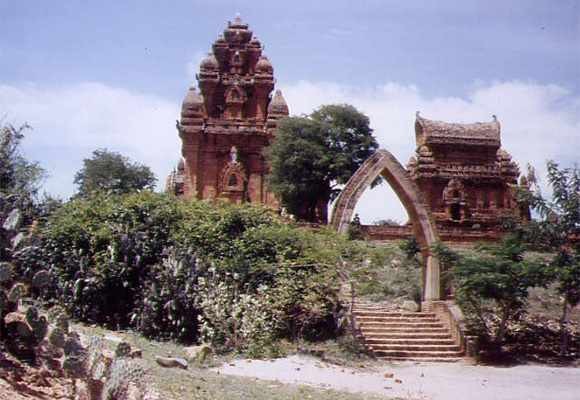 |
| (Photo: hoiantraveltour.vietnamtravelways.com) |
(VOVworld) – The blazing heat of May can’t deter visitors to My Son Sanctuary in the central province of Quang Nam. The complex is now just an expanse of ruins, with a few damaged towers and scattered bricks. So what makes the relic so attractive to domestic and foreign tourists. Let’s find out by exploring My Son with VoV reporter Lan Anh.
Mỹ Sơn is located near the village of Duy Phú, Duy Xuyên District, in the central province of Quang Nam, about 70km southwest of Da Nang and 10 km from the historic town of Trà Kiệu. The temples are in a valley roughly two kilometres wide between two mountain ranges. From Da Nang, visitors can either hire motorbikes or a car or take a one-hour bus ride to My Son.
My Son is Vietnam’s opus in the canon of ancient Southeast Asian holy lands and owes its spiritual origins to the Indian Hinduism of the Cham. Built between the 7th and 13th centuries, the site encompasses 70 architectural structures of baked brick and stone. The My Son Sanctuary temple complex was the central prayer and worship venue of the Cham Pa Kingdom. My Son provided a direct connection between the Cham rulers and their Gods and Saints. For centuries, the Cham built an inter-linked architectural complex of baked brick and sandstone. The main temple worships the Linga-Yoni, who represents the capability to invent and create. Beside the main tower, Kalan, are several smaller-towers for worshipping Genies or deceased kings. The most respected genie is Bhadresvara, a king who built a hall to worship the god Shiva in the form of the Linga and with the name "Bhadresvara," a composite created from the king's own name and the suffix "-isvara" commonly used to refer to Shiva.
One of the most typical characteristics of Cham tower architecture are the stele set against the walls and bricks used to construct the building. Cham people used an early form of mortar for building and artisans carved on the brick walls with sophisticated patterns. Visitor Dinh, from Ho Chi Minh City has this to say ‘I decided to come here to understand more about this nationally and globally recognized site. Although I had heard of it, I couldn’t imagine what it would look like. I now know more about the Cham ethnic people’s culture.
Tran Thi Du Hoai, another visitor, says she and her family flew from Ho Chi Minh City to Da Nang and from there hired a bus to My Son. She was impressed by the historical relic’s beauty ‘Its architecture is very typical and so many years have gone by yet, it remains intact. All the building here were built without using cement’.
In 1898, M.C.Paris, a French scientist, discovered My Son and was surprised by its ancient but majestic beauty. The 30 remaining towers, which date back to the 4th century to the 13th century, have become an invaluable outdoor architectural and sculptural museum depicting the Cham culture. The construction techniques, carvings, and the Cham people’s views of the universe, the gods and mankind makes the tower complex one of the most mysterious in Southeast Asia. Despite the effects of time and wars, the ruins still attract tourists from all over the world. Here’s what a Spanish visitor says about My Son ‘I have visited Hanoi, the imperial city of Hue, Ha Long Bay, Da Nang, the ancient town of Hoi An and My Son. Every place has its own characters, but I’m sad as the temples at this historic site have been seriously destroyed by previous wars. Everything here is completely different from my own culture. The local countryside is stunning and people are also very friendly’.
The temple complex in the A1 style from the 10th century is the most heavily represented style at My Son, and known for its elegance and grace. But now the foundations are all that’s left. Huynh Tan Lap is Deputy Director of the site’s Management Board ‘This is one of the most beautiful temples in My Son with its architecture and sculpture reaching the peak of the Cham group’s creative talent. Due to damage from wars and over time, the temple, except its base, has completely collapsed. A Polish architect to restore the temple in 1980, and gathered some of the remains for the exhibition. The area has become an attractive destination for tourists to visit and research’.
Although there is not much left of My Son Sanctuary, the several remaining temples and towers, represent the end of the Cham culture but still retain their important artistic and spiritual values, according to Huynh Tan Lap ‘Most of the temples in My Son are in serious disrepair, therefore, any of them could collapse at any time. The ongoing preservation work is to protect and regularly clear the site without damaging the relic, as the local weather conditions are extreme with annual torrential rains causing erosion. The international community should treasure the value of My Son Sanctuary, and an increasing number of foreign visitors go there. Last year, 200,000 people visited the site while before 1999 there were only a few thousand a year’.
My Son sanctuary has now become a must go destination for foreign tourists when they visit Vietnam’s central region and local services are greatly improved. My Son has also been included on the world tourism map.
Lan Anh